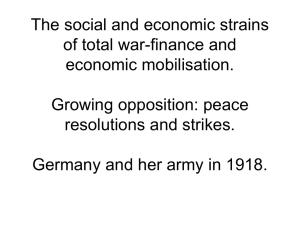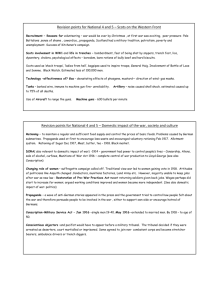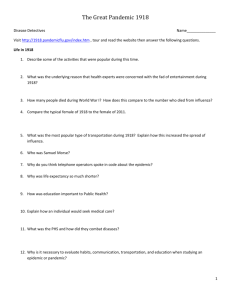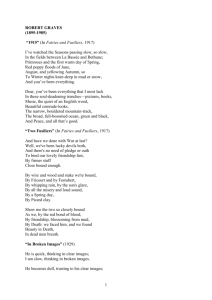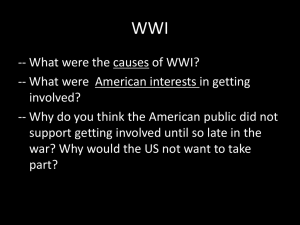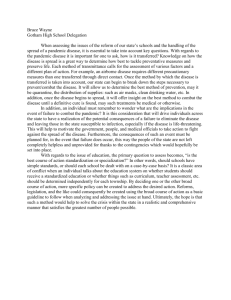The so-called Great Spanish Influenza Pandemic of 1918
advertisement
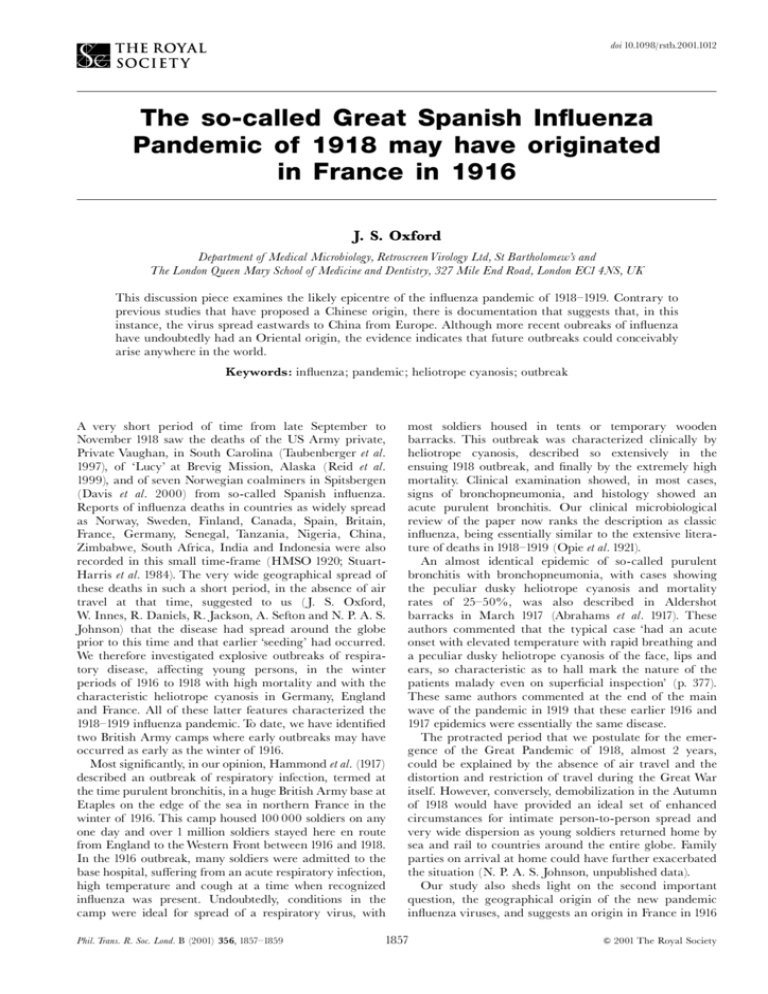
doi 10.1098/rstb.2001.1012 The so-called Great Spanish In¯uenza Pandemic of 1918 may have originated in France in 1916 J. S. Oxford Department of Medical Microbiology, Retroscreen Virology Ltd, St Bartholomew's and The London Queen Mary School of Medicine and Dentistry, 327 Mile End Road, London EC1 4NS, UK This discussion piece examines the likely epicentre of the in£uenza pandemic of 1918^1919. Contrary to previous studies that have proposed a Chinese origin, there is documentation that suggests that, in this instance, the virus spread eastwards to China from Europe. Although more recent oubreaks of in£uenza have undoubtedly had an Oriental origin, the evidence indicates that future outbreaks could conceivably arise anywhere in the world. Keywords: in£uenza; pandemic; heliotrope cyanosis; outbreak A very short period of time from late September to November 1918 saw the deaths of the US Army private, Private Vaughan, in South Carolina (Taubenberger et al. 1997), of `Lucy' at Brevig Mission, Alaska (Reid et al. 1999), and of seven Norwegian coalminers in Spitsbergen (Davis et al. 2000) from so-called Spanish in£uenza. Reports of in£uenza deaths in countries as widely spread as Norway, Sweden, Finland, Canada, Spain, Britain, France, Germany, Senegal, Tanzania, Nigeria, China, Zimbabwe, South Africa, India and Indonesia were also recorded in this small time-frame (HMSO 1920; StuartHarris et al. 1984). The very wide geographical spread of these deaths in such a short period, in the absence of air travel at that time, suggested to us (J. S. Oxford, W. Innes, R. Daniels, R. Jackson, A. Sefton and N. P. A. S. Johnson) that the disease had spread around the globe prior to this time and that earlier `seeding' had occurred. We therefore investigated explosive outbreaks of respiratory disease, a¡ecting young persons, in the winter periods of 1916 to 1918 with high mortality and with the characteristic heliotrope cyanosis in Germany, England and France. All of these latter features characterized the 1918^1919 in£uenza pandemic. To date, we have identi¢ed two British Army camps where early outbreaks may have occurred as early as the winter of 1916. Most signi¢cantly, in our opinion, Hammond et al. (1917) described an outbreak of respiratory infection, termed at the time purulent bronchitis, in a huge British Army base at Etaples on the edge of the sea in northern France in the winter of 1916. This camp housed 100 000 soldiers on any one day and over 1 million soldiers stayed here en route from England to the Western Front between 1916 and 1918. In the 1916 outbreak, many soldiers were admitted to the base hospital, su¡ering from an acute respiratory infection, high temperature and cough at a time when recognized in£uenza was present. Undoubtedly, conditions in the camp were ideal for spread of a respiratory virus, with Phil. Trans. R. Soc. Lond. B (2001) 356, 1857^1859 most soldiers housed in tents or temporary wooden barracks. This outbreak was characterized clinically by heliotrope cyanosis, described so extensively in the ensuing 1918 outbreak, and ¢nally by the extremely high mortality. Clinical examination showed, in most cases, signs of bronchopneumonia, and histology showed an acute purulent bronchitis. Our clinical microbiological review of the paper now ranks the description as classic in£uenza, being essentially similar to the extensive literature of deaths in 1918^1919 (Opie et al. 1921). An almost identical epidemic of so-called purulent bronchitis with bronchopneumonia, with cases showing the peculiar dusky heliotrope cyanosis and mortality rates of 25^50%, was also described in Aldershot barracks in March 1917 (Abrahams et al. 1917). These authors commented that the typical case `had an acute onset with elevated temperature with rapid breathing and a peculiar dusky heliotrope cyanosis of the face, lips and ears, so characteristic as to hall mark the nature of the patients malady even on super¢cial inspection' (p. 377). These same authors commented at the end of the main wave of the pandemic in 1919 that these earlier 1916 and 1917 epidemics were essentially the same disease. The protracted period that we postulate for the emergence of the Great Pandemic of 1918, almost 2 years, could be explained by the absence of air travel and the distortion and restriction of travel during the Great War itself. However, conversely, demobilization in the Autumn of 1918 would have provided an ideal set of enhanced circumstances for intimate person-to-person spread and very wide dispersion as young soldiers returned home by sea and rail to countries around the entire globe. Family parties on arrival at home could have further exacerbated the situation (N. P. A. S. Johnson, unpublished data). Our study also sheds light on the second important question, the geographical origin of the new pandemic in£uenza viruses, and suggests an origin in France in 1916 1857 & 2001 The Royal Society 1858 J. S. Oxford Origin of the Great Spanish In£uenza Pandemic of 1918 Figure 1. Soldiers plucking turkeys on the Western Front. (Photograph: IWM.) Figure 2. One of several well-established piggeries at Etaples camp photographed in 1917. (Photograph: IWM.) Phil. Trans. R. Soc. Lond. B (2001) Origin of the Great Spanish In£uenza Pandemic of 1918 for the greatest in£uenza outbreak of the 20th century and perhaps of all time. At present, most surveillance for in£uenza pandemics is concentrated upon China, and indeed a small outbreak of avian in£uenza was detected in Hong Kong in 1997. As regards an avian origin of pandemic in£uenza, or the mixing-bowl hypothesis in swine, there is photographic evidence of contact of soldiers with live chickens, geese and turkeys (¢gure 1) in the Etaples region, and we have also located piggeries inside the camp at Etaples (¢gure 2; J. Oxford, unpublished data). We cannot exclude the possibility of a Chinese origin of the Great Pandemic, although we think it unlikely. In fact there is documentation suggesting an eastward spread of the virus from Europe towards China in 1918^1919 rather than a westward spread. Chinese labourers were present in the Etaples camp in 1918. However, Vera Brittain, in her classic description of the overcrowded and fraught conditions in this immense base camp at Etaples where she worked as a nurse (Brittain 1989), identi¢es soldiers, administrative and medical sta¡ only of European and Indian origin in 1916^1917. We conclude that it would be wise to incorporate into the present pandemic and surveillance plans the possibility that the next pandemic in£uenza virus may not arise in the Far East but in other parts of the world, including Europe. Figures 1 and 2 are reproduced with permission of the Trustees of the Imperial War Museum, London. Phil. Trans. R. Soc. Lond. B (2001) J. S. Oxford 1859 REFERENCES Abrahams, A., Hallows, N. F., Eyre, J. W. H. & French, H. 1917 Purulent bronchitis: its in£uenza and pneumococcal bacteriology. Lancet ii, 377^380. Brittain, V. 1989 Testament of youth: an autobiographical study of the years 1900^1925. London: Penguin Books. Davis, J. L. (and 11 others) 2000 Ground penetrating radar surveys to locate 1918 Spanish £u victims in permafrost. J. Forensic Sci. 20, 68^76. Hammond, J. A. R., Rolland, W. & Shore, T. H. G. 1917 Purulent bronchitis: a study of cases occurring amongst the British troops at a base in France. Lancet ii, 41^45. HMSO 1920 Report on the pandemic of in£uenza 1918^1919. Reports on Public Health and Medical Subjects, vol. 4. London: His Majesty's Stationery O¤ce. Opie, E. L., Blake, F. G., Small, J. C. & Rivers, T. M. (eds) 1921 Epidemic respiratory disease: the pneumonias and other infections of the respiratory tract accompanying in£uenza and measles. London: H. Kimpton. Reid, A. H., Fanning, T. G., Hultin, J. V. & Taubenberger, J. K. 1999 Origin and evolution of the 1918 `Spanish' in£uenza hemagglutinin gene. Proc. Natl Acad. Sci. USA 96, 1651^1656. Stuart-Harris, C. H., Schild, G. C. & Oxford, J. S. 1984 In£uenza, the virus and the disease. London: Edward Arnold. Taubenberger, J. K., Reid, A. H., Kra¡t, A. E., Bijwaard, K. E. & Fanning, T. G. 1997 Initial genetic characterisation of `Spanish' in£uenza virus. Science 275, 1793^1796.
